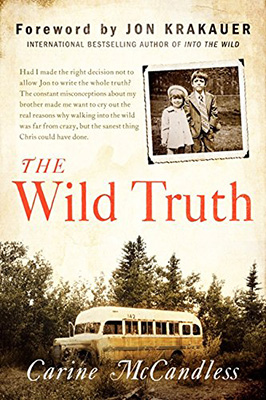 Into the Wild, by Jon Krakauer, was a story which captured my imagination, as well as countless others. It is the story of a young man who cuts himself off from his family and wanders the country. As most people know, even those who have never read the story, his journey ended tragically. Chris McCandless died in the Alaskan wilderness, the story claims he poisoned himself while eating wild potato seeds, though what caused his death has since been debated.
Into the Wild, by Jon Krakauer, was a story which captured my imagination, as well as countless others. It is the story of a young man who cuts himself off from his family and wanders the country. As most people know, even those who have never read the story, his journey ended tragically. Chris McCandless died in the Alaskan wilderness, the story claims he poisoned himself while eating wild potato seeds, though what caused his death has since been debated.
I recently learned about another novel, written by Chris? sister, Carine, The Wild Truth. Carine, frustrated with the misconceptions about why her brother left and the sympathy her parents were receiving for having “such a cruel son”, was pushed to tell the whole story. The story sheds new light on why Chris left, why he had no choice but to cut ties, and how, in doing so, he was not finding himself but finally free to simply be himself.
Reading these stories has given me a new insight into people, into human nature, and into writing. Carine requested that Jon keep most of the details of their childhood out of the novel, not wishing to harm her parents, who, at that time, she still held out hope for. When reading Into the Wild, it was clear to some what occurred in that home, though missed by others, and the extent of it was unknown. Jon’s writing of Into the Wild showcased how to write between the lines, how to suggest without stating. Carine’s novel filled in the blanks, but it does more than that. It tells the story of Carine. How she coped with their childhood, and how she related to her brother leaving with no way of getting in contact with him.
The Wild Truth shows a dark side of humanity. It shows how the cycle of abuse can continue, but also how resilient people can be. It shows that people can be deceived and yet still come out on top. Life may place many obstacles in one’s way but everyone, if they choose, has the strength to overcome them. Carine wound up married twice to abusive partners, though both times they did not show signs of being abusive until after marriage. She held out hope that one day she could reconnect with her parents, even though everyone else had given up and all the signs suggested it was impossible. She is the embodiment of strength, reliance, and perhaps error. She writes bluntly, acknowledging that things about herself and her nature that were difficult to admit to be true had happened.
These stories catch my interest. I find as I read The Wild Truth I am picking out similarities and events that happened in it and Into The Wild, reading each for its own worth, but acknowledging another point of view. It is interesting to see another perspective and to read the other side of the story. While this novel has been out for some time I only just discovered it. These novels (even while I have not completed The Wild Truth) have captured my imagination. The Wild Truth will likely join the ranks of Into the Wild as my most reread books. I encourage anyone who has read and loved Into the Wild to also read The Wild Truth. And, if you have read neither, read both.
Deanna Roney is an AU student who loves adventure in life and literature


